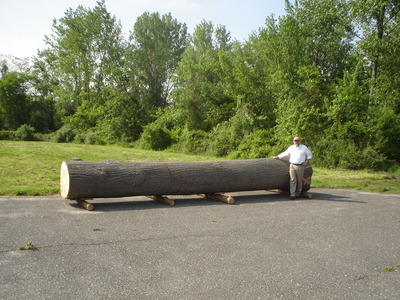Original Vessel for the Navesink River
Our canoe, under construction
Our tuliptree log safely installed at the Red Bank primary school
The original vessel for the Navesink river probably was the dugout canoe. American indians on the Navesink River did not use birch bark canoes, but rather used dugout canoes.
In our area the dugout canoes were probably made from Tuliptree logs, which are by far our largest native tree species, and which is eminently suited for dugout canoe building (another name for the tulip tree is canoe wood). Before steel tools the Lenapi made their canoes mostly by controlled burning, although later canoes used a combination of burning and carving with steel tools.
 In early 2007 we started thinking that it would be fun to build a dugout canoe if we could find a good tulip tree log. It only took our trustee Walt Treacy a few months to find an impressive tulip tree at a friend's house that had to come down to keep the foundation being picked up by the tree.
In early 2007 we started thinking that it would be fun to build a dugout canoe if we could find a good tulip tree log. It only took our trustee Walt Treacy a few months to find an impressive tulip tree at a friend's house that had to come down to keep the foundation being picked up by the tree.
Walt jumped into action and started arranging for the tree company to save the trunk and got our friend and Rendez Vous organizer Jim Hasfeld to agree to move the log on his boat transporter to a suitable building site.
But where to build it?
The Lenapi Great Ghost must have looked down on us, because at the time of our log find we were discussing educational programs with Red Bank primary school and they enthusiastically made the beautiful primary school facility available for the project.
We went at it for a few weeks with adzes and saws and the outside started to look like a canoe, but then when it came time to burning the inside it became apparent that a low key project and fire somehow does not work as well in today's regulatory environment.
For further information contact Rik van Hemmen.

